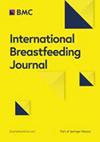Translation and validation of the Breastfeeding Motivation Scale in China
IF 2.9
2区 医学
Q1 OBSTETRICS & GYNECOLOGY
引用次数: 0
Abstract
There are several versions of the Breastfeeding Motivation Scale (BMS), which have been shown to measure maternal breastfeeding motivation, but there is not a Chinese version yet. The study aimed to translate the BMS into Chinese and subsequently assess its psychometric properties among Chinese mothers during the postpartum period. The study was composed of two phases. The translation of BMS closely followed the principals of good practices. Phase 1 included a comprehensive translation, back-translation, cross-cultural adaptation, and pretest to develop the Chinese version of the BMS. From 1 December 2021 to 1 July 2022, the Chinese version of the BMS was administered to 206 postnatal mothers in our maternity wards to assess its psychometric properties. Phase 2 involved psychometric property testing, including testing of the internal consistency, test–retest reliability, content validity, construct validity, convergent validity and discriminant validity. Minor modifications in four items were recommended after translations. The Cronbach's α coefficient of the Chinese version of the BMS was .887, and the intraclass correlation coefficient was .897 (P < 0.001). The model fit was acceptable (χ2/df = 2.40, P < 0.001, RMSEA = 0.08, CFI = 0.91, IFI = 0.92 and TLI = 0.90) according to the confirmatory factor analysis. The composite reliability values corresponding to each latent variable were 0.733 ~ 0.926, and the average variance extracted values were 0.476 ~ 0.653. The correlations among the five measured variables were all lower than .85 and the square roots of average variance extracted from the variable were greater than the interconstruct correlations among the five measured variables in the model. The Chinese version of the BMS has good reliability and validity and provides a reliable assessment tool for measuring maternal breastfeeding motivation. It also provides support to develop culturally sensitive interventions for Chinese mothers’ who are breastfeeding.母乳喂养动机量表在中国的翻译与验证
母乳喂养动机量表(BMS)有多个版本,可用于测量产妇的母乳喂养动机,但目前尚无中文版本。本研究旨在将母乳喂养动机量表翻译成中文,然后评估其在产后中国母亲中的心理测量特性。研究分为两个阶段。BMS 的翻译严格遵循了良好实践的原则。第一阶段包括全面翻译、回译、跨文化改编和预测试,以开发中文版的 BMS。从 2021 年 12 月 1 日至 2022 年 7 月 1 日,我们在产科病房对 206 名产后母亲进行了中文版 BMS 测试,以评估其心理测量学特性。第二阶段涉及心理测量学特性测试,包括内部一致性、重测信度、内容效度、建构效度、收敛效度和区分效度的测试。经翻译后,建议对四个项目略作修改。中文版 BMS 的 Cronbach's α 系数为 0.887,类内相关系数为 0.897(P < 0.001)。根据确认性因素分析,模型拟合度可以接受(χ2/df = 2.40,P < 0.001,RMSEA = 0.08,CFI = 0.91,IFI = 0.92,TLI = 0.90)。每个潜变量对应的综合信度值为 0.733 ~ 0.926,平均方差提取值为 0.476 ~ 0.653。五个测量变量之间的相关系数均小于 0.85,变量平均方差提取值的平方根大于模型中五个测量变量之间的结构间相关系数。中文版 BMS 具有良好的信度和效度,为测量母亲母乳喂养动机提供了可靠的评估工具。它还为针对中国母乳喂养母亲制定文化敏感性干预措施提供了支持。
本文章由计算机程序翻译,如有差异,请以英文原文为准。
求助全文
约1分钟内获得全文
求助全文
来源期刊

International Breastfeeding Journal
Medicine-Obstetrics and Gynecology
CiteScore
6.30
自引率
11.40%
发文量
76
审稿时长
32 weeks
期刊介绍:
Breastfeeding is recognized as an important public health issue with enormous social and economic implications. Infants who do not receive breast milk are likely to experience poorer health outcomes than breastfed infants; mothers who do not breastfeed increase their own health risks.
Publications on the topic of breastfeeding are wide ranging. Articles about breastfeeding are currently published journals focused on nursing, midwifery, paediatric, obstetric, family medicine, public health, immunology, physiology, sociology and many other topics. In addition, electronic publishing allows fast publication time for authors and Open Access ensures the journal is easily accessible to readers.
 求助内容:
求助内容: 应助结果提醒方式:
应助结果提醒方式:


